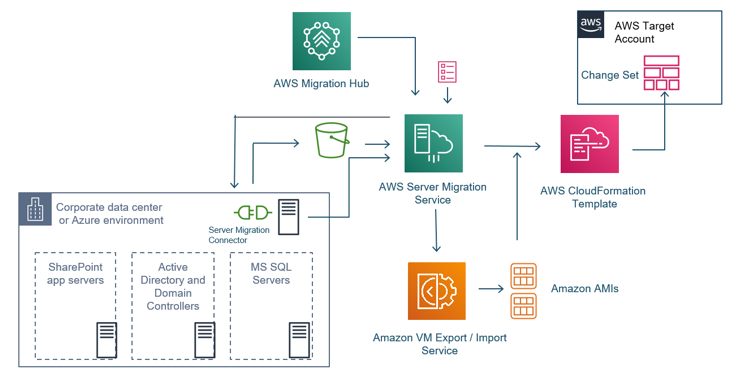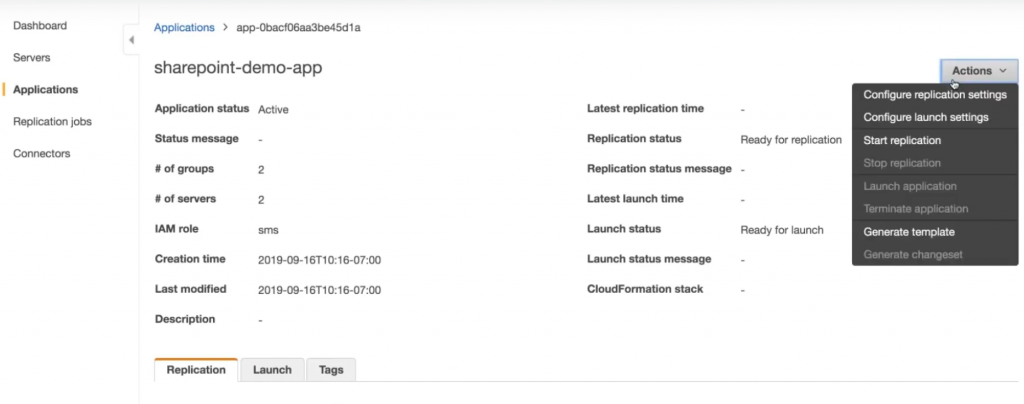AWS Compute Blog
Migrating a SharePoint application using the AWS Server Migration Service
This post is contributed by Ashwini Rudra, Solutions Architect; Rajesh Rathod, Sr. Product Manager; Vivek Chawda, Senior Software Engineer, EC2 Enterprise
Many AWS customers are migrating on-premises SharePoint workloads to AWS for greater reliability, faster performance, and lower costs. While planning the migration, customers are looking for tools and methodologies that reduce the time to migrate, application downtime, and performance disruption. They use continuous replication to optimize cost and effort required to migrate applications reliably.
To accelerate these migrations, AWS provides a comprehensive set of tools. In this blog post, we explore how to use AWS Server Migration Service (AWS SMS) for migrating a SharePoint application from on-premises to AWS.
Overview of solution
AWS Server Migration Service is an agentless service. It makes it easier and faster to migrate thousands of workloads from on-premises or Microsoft Azure to AWS. In this article, we discuss one of the approaches and steps to migrate SharePoint farm using AWS SMS.
AWS SMS also supports migrating a group of servers organized as an application. This can simplify migration of applications with complex dependencies that must be migrated together. This service provides a customized replication schedule designed to simplify migration at scale. This also tracks the progress of each migration using AWS Migration Hub.
For SharePoint migrations, it facilitates migration failovers quickly. After the initial sync, the migration uses an incremental change capture approach to synchronize changes made to the on-premises SharePoint servers. This method also reduced required network bandwidth for the migration.

SharePoint Migration Architecture
Here is how this service and solution works:
Walkthrough
A basic SharePoint deployment is a 3-tier architecture comprising of web frontend servers, application servers, and backend SQL database servers. It also includes authentication services servers with Active Directory domain controllers.
To migrate this application, you must deploy a Server Migration Connector, which is a preconfigured virtual machine. This connector creates a server catalog. Based on selected server and configuration, it takes snapshots of virtual machines and stores them in S3 buckets.
In the background, AWS VM import/export service converts these snapshots into Amazon Machine Images (AMIs). Using these AMIs, you can configure launch settings where you define an order of application launch. You can also select instance types and set user-defined PowerShell scripts.
At the end, you define the cloud network topology: a VPC, subnets, and security groups. With these launch settings, SMS creates an AWS CloudFormation template, which can launch the SharePoint application in the target AWS account.
To migrate a SharePoint using SMS:
- Install and register the SMS connector.
- Create an application from SMS server catalog.
- Configure replication settings for your SharePoint farm.
- Configure launch settings.
- Start the replication.
- Launch the SharePoint application in AWS.
Install and register the Server Migration Connector
The Server Migration Connector is a VM that you install in your on-premises virtualization environment. The supported platforms are VMware vSphere, Microsoft Hyper-V/SCVMM, and Microsoft Azure. Follow the links below to install in your environment:
- Install Server Migration Connector on VMWare
- Install Server Migration Connector on Hyper-V
- Install Server Migration Connector on Azure
For example, VMWare is a common scenario. First, you must set up Server Migration Connector and import server catalog:
- Login to AWS Server Migration Service Console, and click to Connectors.
- Download .ova file and deploy it to your VMWare environment using vSphere client from AWS Server Migration Setup page.

- Install OVA file on your VMWare environment. This is your AWS SMS Connector.
- Use Connector Host IP address access Connector page and start five step registration process. Refer AWS documentation, Install the Server Migration Connector on VMWare.
- Follow the five-step process of registration. Here, you set up the password and network configuration between the connector virtual machine and AWS accounts.

Setup network info

vCenter credentials
At the end, provide your vCenter host name and credentials.
In setup, provide all details of the VMWare and AWS environment to the connector. After establishing the connection, the connector setup looks like this in the AWS Management Console:

SMS Connectors
Create an application from SMS server catalog
After configuring the connector and selecting “Import Server Catalog”, you are able to view the server catalog in AWS Server Migration Service console. To migrate your SharePoint application, select the application server, SQL Server, and Active Directory server from the server catalog.
Depending on the application architecture, you can group these servers to apply server-specific configuration settings and select appropriate instance types. Here are the steps:
- Navigate to the application feature of SMS and create a “new application” for the SharePoint farm. Provide the application name, description, and IAM role.

Create new application – Application settings
- Select servers to migrate from the catalog.
- Create different groups for these servers in your console. For this, select servers and choose Add servers to group. This helps in defining different instance types and run user-defined PowerShell scripts for all servers in a group during application launch. You may create different groups for the application, web frontend, database, and Active Directory servers. In the below example, there are two groups – one for application servers, and the other for database servers. This process assumes that you have the authentication services servers already in place and operational in AWS. For more information on SharePoint authentication services, Active Directory and Domain Services, Refer Active Directory Domain Services on AWS Deployment Scenario and Architecture.

Create new application – Add servers to groups
- Add tags, per your organization tagging strategy or policy.
- Review your application and click “Next” when it is ready for replication settings configurations.
Configure replication settings
- Define “replication job type”, “when to start replication job”, and “automatic AMI deletion” based on your requirements. Choose Next.
- On the Configure server-specific settings page, in the License type column, select the license type for AMIs created from the replication job. Windows Servers can use either an AWS-provided license or Bring Your Own License (BYOL). Check Microsoft Licensing to review the licensing options. You can also choose Auto to allow AWS SMS to detect the source-system operating system (OS) and apply the appropriate license to the migrated virtual machine. Choose Next.

Server-specific settings
- Review your application replication setting and choose Configure Launch Settings.
Configure launch settings
An important aspect of migration is how this application should launch on EC2. This is configured on this page of SMS:
- On the Configure launch settings page, for the IAM CloudFormation role, provide an IAM role for launch settings. Refer AWS Documentation on IAM Roles for AWS SMS.

Configure launch settings
- Under Specify launch order, configure a launch order for your groups. For this SharePoint application, you may prefer Active Directory first, followed by the SQL database, and then the application servers.
- Under Configure launch settings for the application, edit the server settings individually:

Target instance details
- Logical ID: AWS CloudFormation resource ID. This is the logical ID of the CloudFormation template that AWS SMS generates for the application. A value is created automatically when you use the console, but you must supply it manually when using the API, CLI, or SDKs. For more information, see Resources in the AWS CloudFormation User Guide.
- Instance type: specifies the EC2 instance type on which to launch the server.
- Key pair: specifies the SSH key pair for access to the server.
- Configuration script: a script to run configuration commands at the startup of EC2 instances launched as part of an application. This is important for your SharePoint migration, as you can provide registry settings and configuration settings using PowerShell script for your SharePoint servers and SQL database servers.
For example, the PowerShell script below retrieves the IP address of the current SQL Server and replaces the old SQL Server IP in the SharePoint configuration database and connection strings. You can automate many SharePoint configuration tasks using PowerShell scripts.
Start-Transcript -Path "C:\UserData.log" -Append $oldIP = <<Your old IP goes here>> $newIP = ([System.Net.Dns]::GetHostAddresses("sp-ip-sql-server.aws.local")).IPAddressToString $registryPath = "HKLM:\SOFTWARE\Microsoft\Shared Tools\Web Server Extensions\16.0\Secure\ConfigDB" $Name = "dsn" $regValue = (Get-ItemProperty -Path $registryPath -Name $Name).dsn $updatedRegValue = $regValue.Replace($oldIP, $newIP) New-ItemProperty -Path $registryPath -Name $Name -Value $updatedRegValue -PropertyType String -Force | Out-Null - Configure the target network: VPC, subnets and security groups. Refer to the SharePoint on AWS documentation (Reference Deployment) for more guidance. The network topology varies based on platform requirements. Here is a reference architecture for SharePoint on AWS:

Architecture topology
Start application replication
To start replication, select Start Replication under the Actions menu on the Applications page. The replication time depends on the amount of data replicated and available network bandwidth. On the application details page, you can observe the status of the replication in the Replication status field. If the replication fails, the status message field shows the reason.

Start replication
Launch SharePoint in AWS
- On the Application page, choose Actions, Launch application. A replication job must complete before you perform this action.
- In the Launch application window, choose Launch. On the application details page, you can observe the status of the launch in the Launch status field. If the launch fails, you are able to find the reason in the status message field. You can also generate a CloudFormation template and download this template to use in different AWS accounts.

Launch application
Test your migration
When the SharePoint application is launched, you can connect to Amazon EC2 instances based servers via Remote Desktop Protocol (RDP). You can access the application based on your Internet Information Services (IIS) Server settings runs on SharePoint Web Front End (WFE) application server (on Amazon EC2). It is also recommended to investigate optimizations using the AWS Compute Optimizer. For this blog, we have not verified the migration steps with SharePoint 2007 and 2010.
Conclusion
AWS Server Migration Service simplifies SharePoint application migration. Using AWS SMS, you can easily migrate a SharePoint farm and reduce your migration timeline using the launch setting and launch order features.
To learn more, watch Application migration Using AWS Server Migration Service (SMS) or view a demo on the AWS Online Tech Talks Channel. If you have feedback, let us know in the comments section below.